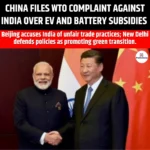PM Modi’s Historic Visit to Croatia
|
General Studies Paper II: Bilateral Groupings & Agreements, Effect of Policies & Politics of Countries on India’s Interests |
Why in News?
Recently, Prime Minister Narendra Modi travelled to Croatia on June 18, 2025, making history as the first Indian Prime Minister to visit the nation.
- His arrival signalled a strong commitment to upgrading ties that had remained mostly symbolic since diplomatic relations began in 1992.
Key Highlights of PM Modi’s Historic Visit to Croatia
- Agreements:
-
-
- Both the countries signed four key agreements:
- An MoU on Agricultural Cooperation
- A Programme of Cooperation in Science and Technology
- A Cultural Exchange Programme (CEP)
- An MoU to establish a Hindi Chair at the University of Zagreb.
- Both the countries signed four key agreements:
-
- Trade Connectivity:
-
-
- Croatia expressed willingness to become a key link between the Mediterranean and Central Europe, using its strong maritime experience.
- Both countries also reaffirmed respect for international maritime law and UNCLOS principles.
-
- Technology Exchange:
-
-
- They encouraged long-term exchanges between young researchers and cooperation in developing applied technologies.
- India and Croatia also highlighted the benefits of shared expertise in areas like AI, cybersecurity, Agri-tech, and Clean-tech.
-
- Strategic Security:
-
-
- Building on the 2023 MoU on Defence Cooperation, both sides committed to enhancing military ties.
- The focus will shift to collaborations between defence industries and organising regular technical exchanges.
-
- Digital Economy:
-
- Both governments agreed to deepen the India–Croatia Start-up Bridge, linking incubation centres and tech start-ups.
- Partnership Goals:
- Both sides supported completing the India–EU Free Trade Agreement (FTA) within the timeline of the year 2025.
- The two governments agreed to move forward with signing a Memorandum of Understanding on workforce mobility.
- Croatia and India expressed joint support for reforms at the United Nations, with a special focus.
- During PM Modi’s visit, both sides signed a Cultural Exchange Programme (CEP) for the 2026–2030 period.
India–Croatia Bilateral Relations
- Diplomatic Roots:
- India granted official recognition to Croatia in May 1992, followed by the formal establishment of diplomatic ties on 9 July 1992.
- When Croatia was a Yugoslav republic, it contributed over two-thirds to India–Yugoslavia trade and supplied ships during the 1970s and 1980s.
- Leaders like Tito and Nehru, both Non-Aligned Movement founders, maintained close ties.
- Growth Through Agreements:
- India and Croatia have signed a series of bilateral agreements on diverse areas:
- Trade and Economic Cooperation (2017)
- Maritime Transport (1997)
- Air Services (2000)
- Investment Protection (2001)
- They also completed key MoUs between financial, tech, educational, and cultural institutions since 2000, including Hindi and Sanskrit Chairs at Zagreb (2009, 2019).
- The India–Croatia Startup Bridge, created in 2021, is driving collaboration in areas like AI, green tech, and clean energy.
- India and Croatia have signed a series of bilateral agreements on diverse areas:
- Economic Ties:
- In 2019, Indian direct investments worth €32.5 million flowed into Croatia, while Croatian investment in India stood at €5.5 million.
- India’s exports to Croatia in 2024 amounted to $251.6 million, while imports from Croatia reached $54.4 million.
- From 2021, both countries launched a Startup Bridge backed by organizations like Infobip and Končar, leading to competitive start‑up events.
- Universities—such as Zagreb’s FER and IIT Gandhinagar, IIM Lucknow and IIT Indore—started joint programmes reflecting increased academic cooperation.
- Cultural Ties:
- A Croat–Indian Society formed in 1994 promotes events and ISKCON centres in Croatia
- A Croatian Ayurveda Cell began operations in 2015–16.
- MoUs on tourism, sports, and educational exchange since 2019 .
- They also discussed cooperation in skill development, with proposals under India’s New Education Policy .
- Multilateral Cooperation:
- Both nations cooperate in global forums such as the UN, non-aligned and climate platforms.
- They also partner in G20 and Raisina Dialogue events.
- Croatia supports India’s permanent seat in a reformed UN Security Council.
Introduction of Croatia
- Geography & Location:
-
- Croatia lies in Central and Southeast Europe, hugging the Adriatic coast and stretching inland.
- It shares borders with Slovenia, Hungary, Serbia, Bosnia & Herzegovina, and Montenegro, and includes an exclave near Dubrovnik.
- The country covers about 56,594 km², making it the 127th-largest globally.
- Its terrain spans from the Pannonian plains in the north, through the Dinaric Alps, to a rugged, island-studded coastline featuring over 1,100 islands.
- Capital City & Administrative Setup:
- Zagreb is the capital and the biggest city of Croatia, with a metropolitan population estimated at around 978,000.
- The country functions as a unitary parliamentary republic with 20 counties and Zagreb as its own administrative entity.
- Currency & EU Integration:
- Croatia switched to the euro (€) on 1 January 2023, replacing the kuna, which had been in use since 1994 and pegged to the Deutsche Mark and later the euro.
- Historical Overview:
- The land of modern Croatia belonged to Roman provinces of Pannonia and Dalmatia, later ruled by the Ostrogoths and Byzantines.
- A Croatian duchy rose in the 7th century, evolving into a kingdom by 925 AD, which later formed unions with Hungary and the Habsburg Empire.
- In the 20th century, Croatia became a republic within Yugoslavia, before declaring independence in 1991, ending in the Croatian War of Independence and becoming fully sovereign by 1998–2002.
- Constitution & Governance:
- Croatia’s current constitution was adopted on 22 December 1990 and has undergone several amendments, most recently in 2014.
- It established a parliamentary democratic republic, where the President serves as head of state and the Prime Minister leads the government.
- Climate & Natural Features:
- The Croatian coastline has a Mediterranean climate with dry summers and mild winters, while inland areas face hot summers and cold winters.
- Its natural landscape includes rivers like Sava, Drava, and Danube, plus mountains, karst caves, and scenic lakes such as Plitvice.
- Biodiversity:
- Croatia ranks among Europe’s most biodiverse nations, with approximately 50,000–100,000 species across 444 protected areas, covering around 8.5% of its land.
- International Alliances:
- Since gaining independence in 1991, Croatia joined the UN (1992), NATO (2009), and the EU (1 July 2013).
Why Croatia Matters for India?
- Maritime Location: Croatia sits on the eastern Adriatic Sea, making it a key link for maritime trade between India and Europe.
- Its main ports—Rijeka, Split, and Ploče—are important parts of the EU’s Trans-European Transport Network (TEN-T).
- These ports give India direct entry points into European markets, reducing reliance on older routes like the Suez Canal, which often face delays or disruptions.
- Role in the IMEC Corridor: Croatia plays a vital part in India’s India–Middle East–Europe Economic Corridor (IMEC) plan.
- This route connects India to Europe via the Middle East, bypassing congested Western European ports.
- Croatia’s location enables smooth distribution to Central and Eastern Europe, areas where Indian exports are increasing.
- Through Croatia, India can cut time and costs while expanding reach across multiple European zones.
- Political Importance: As a member of both the European Union and NATO, Croatia holds influence in critical policy circles.
- For India, this means having a friendly nation inside European institutions, ready to support mutual goals.
- Croatia’s position helps India in its EU–India Free Trade Agreement discussions, which have faced delays due to complex regulations and politics.
- Partner in Global Diplomacy: Croatia has consistently backed India in international organisations.
- It supports India’s permanent seat in the UN Security Council, and refrains from interfering in sensitive matters like Jammu and Kashmir.
- Unlike some larger EU countries that often take shifting stands, Croatia remains steady and reliable.
- This kind of diplomatic consistency makes Croatia a dependable friend for India on the world stage.
- Rising Trade Relations: Although Croatia has a small population, Indian companies view it as a launchpad into the wider EU market.
- In sectors such as IT, engineering, and pharmaceuticals, Indian firms are investing and expanding through Croatian partnerships.
Bilateral trade between India and Croatia reached USD 337.68 million in 2023, reflecting steady growth and future potential.








